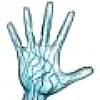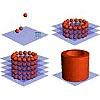Vacuum Cleaner Invention
McGaffney
In 1866, Ives W. McGaffney created the first vacuum cleaner invention. It used a hand crank with bellows to create a vacuum in a tube.
A vacuum works by creating a difference of air pressure.
Air is removed from a tube and atmospheric pressure pushes air and debris on a surface up into the tube.
Manual Models
There were several non-electric vacuum cleaners invented in England, France, and the United States.
Most of these inventions required two people to operate them. One person would pump while the other vacuumed.
Besides hand-cranking, there were also foot-operated models available, There was even a Swiss vacuum cleaner invention that used a rocking chair for pumping.
The problem with many of these vacuums was that they didn't capture the dirt and dust. They only redistributed it by blowing it out a hose elsewhere.
Hubert C. Booth
The first powered vacuum cleaner invention that actually captured debris was invented in 1901 by Hubert Cecil Booth.
While on a train ride, after observing a vacuum redistributing dust from chairs, Booth got the idea that a vacuum should capture dust.
He tested his idea by putting a handkerchief across his mouth and sucking as much dust as possible into the handkerchief. Gotta love those moments of inspiration.
Booth began immediately working on his new idea. He designed and patented a vacuum cleaner powered by an oil engine. It was a huge machine, appropriately called the "Puffing Billy," and it captured dirt inside a filter.
Marketing Concept
The Puffing Billy was too large, noisy, and cumbersome to put into a home or factory so Booth decided to market a service instead.
He invented the first carpet cleaning business.
His machine was mounted onto a horse-drawn carriage and he went door-to-door offering to vacuum dirt from homes.
Booth extended long hoses into homes through the windows. He used transparent hoses so customers could see the dirt leaving their house, and he dressed his staff in professional cleaning uniforms.
The business was so successful, and was such a novelty, that it became an event to have your home vacuumed. Customers held tea parties where invited guests would be entertained by watching Puffing Billy suck dirt through it's transparent hoses.
Booth received a lot of publicity when he used his machine to clean the carpets at Westminster Abbey in preparation for King Edward VII's coronation. He received even more publicity when he vacuumed the Royal Mint.
After leaving the Mint, the police stopped Booth and confiscated his filter bag. Apparently, he had mistakenly sucked up a small fortune in gold dust from the vaults.
Booth continued to expand his carpet cleaning empire. He converted the Puffing Billy from an oil engine to an electric motor and also designed and sold industrial vacuums to factories.
W. H. Hoover
Hoover is a household name for vacuum cleaners. As a matter of fact, in Britain, the generic term for a vacuum cleaner is a “hoover”.
Hoover was a businessman that was looking to diversify his business interests.
His company, "Hoover Harness and Leather Goods", supplied the horse trade and it was being adversely affected by the invention of the automobile.
Hoover purchased the rights to a vacuum cleaner invention that used rotating brushes, which was created by James Spangler of Canton, Ohio. Hoover began marketing the invention in 1908 as "The Electric Suction Sweeper Company", which became The Hoover Company.
New Vacuums
As technology advances, inventors continue to improve the vacuum. There are now vacuums that do not use bags or filters to capture debris, and some that operate as robots.
Following in the footsteps of Hubert Cecil Booth, entrepreneurs are also finding new ways to market the next best vacuum cleaner invention.

|
| Student gets 1.2 million dollar investment for his dicycle invention. |

|
| New handheld device can identify you by scanning the veins in your hands. |





